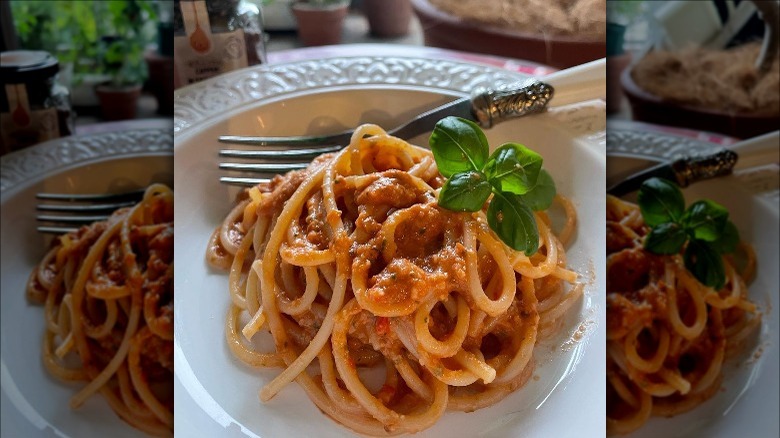The Pesto Sauce Giada De Laurentiis Can't Stop Buying
When most people think of pesto, chances are they're thinking of a bright green basil sauce, like the kind invented in Liguria, Italy in the 19th century. But there are many different versions of pesto out there, and they can vary widely between different regions of the country. After all, the word pesto comes from "pestare," an Italian word that means "to pound or crush," so pretty much any sauce made in a mortar and pestle counts. Varieties of pesto were popping up as far back as the Middle Ages, although the smashed blend of walnuts and garlic favored then is a little different than what we recognize as pesto today. Food Network star Giada De Laurentiis loves the basil-forward pesto alla genovese as much as anyone, but she recently took some time to highlight another favorite: pesto pantesco, which originates from the Italian island of Pantelleria.
Pantelleria is located off the western coast of Sicily, and both islands have similar cuisines. While pesto alla genovese features basil, pine nuts, and parmigiano-reggiano cheese, Sicilian pestos tend to rely on ingredients that thrive in the hot, sunny climate of the Mediterranean islands, like tomatoes, capers, and almonds. But De Laurentiis' favorite pesto pantesco is unique, as it eschews the classic choice of capers in favor of chili and herbs.
Varieties of pesto pantesco
Giada De Laurentiis' favorite brand of pesto pantesco is sold on her website Giadzy and comes from the brand Kazzen Oro Di Pantelleria. This specific type is made with tomatoes, olive oil, garlic, basil, almonds, parsley, oregano, red pepper, and mint, but variations include swapping out nuts for toasted breadcrumbs or adding in Pantelleria's prized capers. Some use fresh tomatoes while others use sun-dried; occasionally passito di Pantelleria, a sweet wine made from dried grapes, is added as well. There are even versions that contain smoked fish.
Pesto alla genovese is traditionally tossed with handmade pasta, especially a short, twisted shape known as trofie. But pesto pantesco from Pantelleria can be combined with any type of pasta, and is often used as a sauce for fish (grilled swordfish is a popular option in Sicilian cuisine) and other meats, or as a topping for toasted bread (à la classic tomato bruschetta). With its bold flavors and flexibility, it's no wonder De Laurentiis deems this a unique Italian food worth trying. Those interested in learning more can simply follow their pesto cravings — from the ingredients used to the way it's served, regional variations of pesto can tell you a lot about Italian culture and history.

